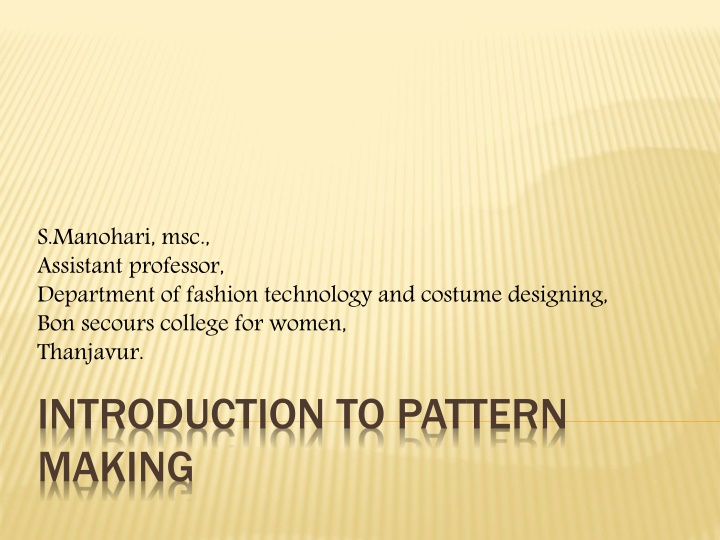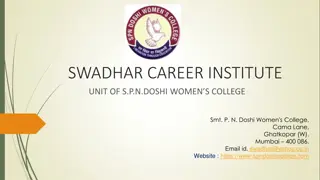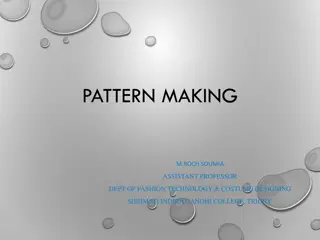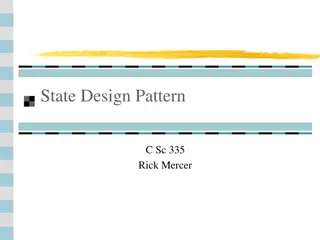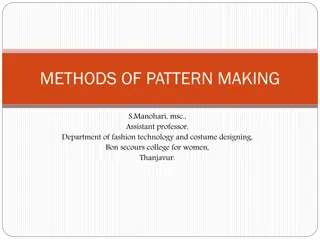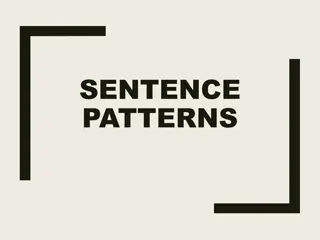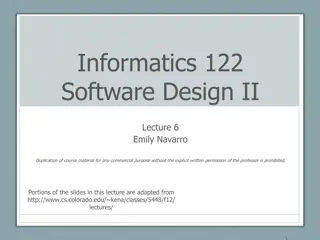Introduction to Pattern Making in the Fashion Industry
Pattern making is a crucial aspect of garment manufacturing, serving as a template for garment components. It requires technical skills, design interpretation, and construction understanding. The process involves drafting patterns based on measurements before cutting and assembling fabric. Different types of paper patterns, including standardized, individual, final, block, and readymade, cater to various needs in the industry.
Download Presentation

Please find below an Image/Link to download the presentation.
The content on the website is provided AS IS for your information and personal use only. It may not be sold, licensed, or shared on other websites without obtaining consent from the author.If you encounter any issues during the download, it is possible that the publisher has removed the file from their server.
You are allowed to download the files provided on this website for personal or commercial use, subject to the condition that they are used lawfully. All files are the property of their respective owners.
The content on the website is provided AS IS for your information and personal use only. It may not be sold, licensed, or shared on other websites without obtaining consent from the author.
E N D
Presentation Transcript
S.Manohari, msc., Assistant professor, Department of fashion technology and costume designing, Bon secours college for women, Thanjavur. INTRODUCTION TO PATTERN MAKING
PATTERN Pattern Pattern is a hard paper which is made by following each individual component for a style of garment or apparel. Actually pattern is a template from which the parts of a garment are traced onto fabric before being cut out and assembled. It is one of the most important parts of garment garment manufacturing manufacturing industry. Pattern making making is a highly skilled technique which calls for technical ability, sensitivity for design interpretation and a practical understanding construction construction. Pattern making is a bridge function between design and production. Pattern of garment garment
PATTERN MAKING PATTERN MAKING Pattern Pattern Making on the basis of which the fabric is cut. It is the technical drawing or drafting of a garment. Standard size charts, dress forms or figure are measured, these measurements are then converted into 2D patterns patterns and then garments are made from them. Making is a blueprint for the garment,
TYPES OF PAPER PATTERN TYPES OF PAPER PATTERN 1 1. . Standardized Standardized prepared using standardised body measurements are called standardised paper patterns. This method is followed in training paper paper pattern pattern: : Paper patterns and tailoring schools. 2 2. . Individual Individual paper particular person is taken and a pattern is prepared using these individual measurements. The pattern prepared for a particular person will not suit another person. These are usually done at home and some tailor shops. paper pattern pattern: : The measurement of a
TYPES OF PAPER PATTERN TYPES OF PAPER PATTERN 3 3. . Final Final paper the paper patterns, they are made into final paper patterns. Though, while making individual patterns all the precautions are taken, yet, there could be some minor points, which are to be considered. These minor details are corrected and finally made into permanent patterns. paper patterns patterns: : Once the individual is satisfied with 4 4. . Block Block paper standard sizes with thick cardboard. These are mostly used in the garment industry. The garment made out of these block patterns will fit those who have measurements equal to that of the standardised body measurement. paper pattern pattern: : Normally these are made with
TYPES OF PAPER PATTERN TYPES OF PAPER PATTERN 5. Readymade patterns: 5. Readymade patterns: These are made using a unique type of tracing paper. These can be procured from the market and are more useful for people who can do stitching, but not drafting. These can be bought readymade and can be easily used by placing on the material and cutting and stitching accordingly. 6. Graded paper pattern: 6. Graded paper pattern: Patterns of five consecutive sizes (e.g. 30 , 32 , 34 , 35 and 38 chest size) are marked in one single pattern. The required size according to the individual body measurement is traced separately, cut and used. 7. Commercial paper pattern: 7. Commercial paper pattern: The paper patterns for different designs are available in readymade forms. These patterns are called commercial patterns. These patterns are enclosed in an envelope along with an instruction sheet. The instruction sheet will provide information about selection of fabric, preparation of fabric, marking, cutting, and steps for sewing. The front side of the envelope contains the front view, side view and back view of the garment design along with the body measurements.
WORKROOM TERMS 1. CUT AND SEW 1. CUT AND SEW Knit fabrics that are laid out and cut like a woven fabric, instead of being full-fashioned 2. CAD 2. CAD Computer Aided Design- used as a conceptual tool to design and develop products 3. FLAT SKETCHES 3. FLAT SKETCHES Technical sketch of a product as if it were laying flat- includes stitching & seaming details 4. FULL 4. FULL- -FASHIONED FASHIONED Knit garments that have been shaped on a flat knitting machine
WORKROOM TERMS 5. GRADING 5. GRADING Proportionately increasing or decreasing the dimensions of parts of a product according to the size ranges intended for production. 6. KNIT 6. KNIT Fabric created by interlocking loops of yarn 7. MARKER 7. MARKER A full-scale diagram, usually on paper, indicating the most fabric conscience placement for all the graded pattern pieces in a garment. Used in the fabric cutting process for production. 8. MINIMUMS 8. MINIMUMS The minimum quantity that a vendor requires in order to contract their goods or services. 9. PATTERN 9. PATTERN A paper or computer model for each piece of a product. Used as a guide to construct a product. 10. PROTOTYPE 10. PROTOTYPE A full size working model of a new product or new version of an existing product used as a basis for later production stages.
WORKROOM TERMS 11. PURCHASE ORDER (PO) 11. PURCHASE ORDER (PO) A legal, binding contract between a buyer and a supplier. 12. SOURCING 12. SOURCING Process of obtain goods and/or services from a manufacturer either domestically or globally. 13 13. . TECHNICAL TECHNICAL SPEC SPEC PACKAGING PACKAGING (TECH (TECH PACK) Includes all the information to communicate to a vendor how to produce a product (size, fabrication, quality standards, etc.) 14. WOVEN 14. WOVEN Fabric composed of two yarns running in perpendicular directions woven together 15. FABRIC CONSTRUCTION 15. FABRIC CONSTRUCTION The specific base construction of a fabric: (knit, woven, or non- woven), type of structure and size/weight. PACK)
ADVANTAGES OF PAPER PATTERN: ADVANTAGES OF PAPER PATTERN: A better pattern of the appropriate size manipulated to individual requirements results in a better fit. A pattern made in a thick paper or cardboard shall be maintained for a longer period of time and can be reused several times. By modifying the basic pattern pieces using the flat pattern technique, it is feasible to make patterns for intricate and original designs. A paper pattern of a specific size can be used to produce patterns of other sizes by means of a grading process. The errors that occur during pattern drafting can be corrected in the pattern itself. Patterns can be changed/modified according to the latest fashion trend.
